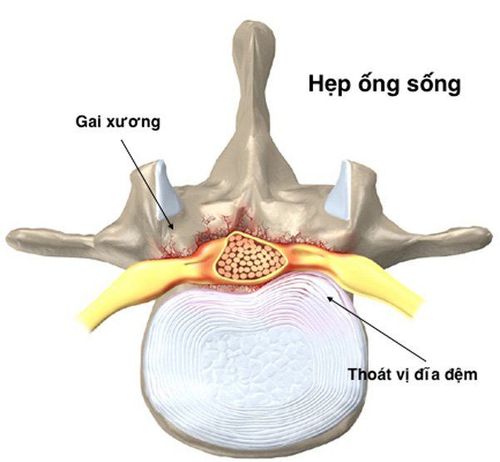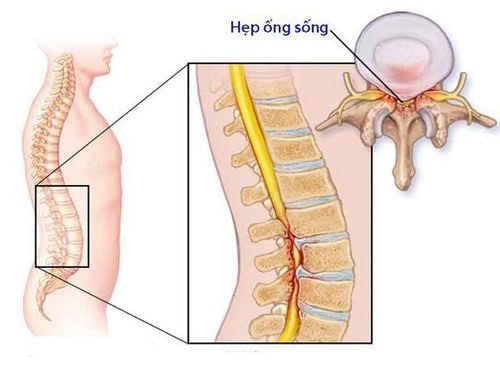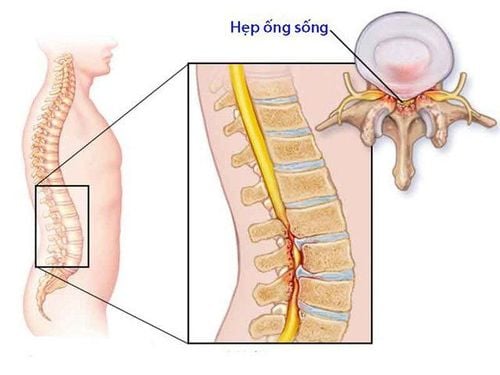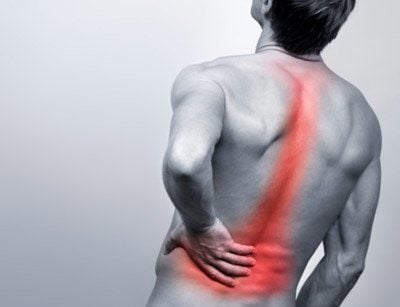This is an automatically translated article.
Spinal stenosis usually progresses over a long period of time and leaves chronic pain. Spinal stenosis surgery is performed when the patient does not respond to other treatments.1. What is spinal stenosis?
The lumbar spine consists of five vertebrae in the lower part of the spine, between the ribs and the pelvis.
Spinal stenosis causes compression of the nerves that go from top to bottom to the legs. It is common in the elderly (60 years of age and older) due to a degenerative condition. However, spinal stenosis can still occur in young people, due to a number of different causes during development.
Lumbar stenosis usually progresses slowly, over years or decades. With age, the disc becomes less elastic, leading to a decrease in disc height and can cause the nucleus pulposus to protrude into the spinal canal, and there may be bone spurs and thickening of the ligaments. All of these factors contribute to narrowing of the spinal canal and can cause symptoms. Symptoms of spinal stenosis can be caused by inflammation, nerve compression, or both.

Hẹp ống sống gây ra chèn ép vào các dây thần kinh
2. Is spinal stenosis dangerous?
Sometimes the symptoms of spinal stenosis come on immediately, but in general they develop over a long period of time, causing chronic pain.
Spinal stenosis due to herniated disc often causes significant nerve damage, leading to many dangerous complications. In the severe stage, the patient may experience muscle atrophy and paralysis. Lumbar spinal stenosis can cause loss of mobility in the legs, affecting the patient's walking function. There are even many cases of circular muscle disorders, causing urinary or bowel obstruction.
3. When is surgery needed for spinal stenosis?
Spinal stenosis, especially lumbar spinal stenosis, is a very common disease. This disease can cause mild to severe symptoms such as back pain and great sciatic nerve pain, which can spread to both legs and cause paresthesias (numbness and tremors), sometimes muscle paralysis and confusion. circular muscle disorder, urinary retention...
Regarding treatment, depending on the patient's condition, if it is mild or moderate, medical treatment, the aim is to relieve symptoms by using pain relievers, massage, acupuncture, Physical therapy, mild sedatives and high-dose B vitamins are also effective because the drug acts on anti-inflammatory and anti-degenerative processes, especially in nerve organization...
Indications for surgery Spinal stenosis surgery is indicated when the patient does not respond to conservative treatments (drugs, spinal stretching, rehabilitation...).

Hẹp ống sống thắt lưng là một bệnh lý rất hay gặp, gây ảnh hưởng đến chất lượng cuộc sống của người bệnh
Patients are considered for spinal stenosis surgery if:
Back and leg pain limits normal activities, or affects quality of life. The disease progresses to neurological deficits (leg weakness, droopy feet, numbness in the extremities). Loss of bowel and/or urinary function. Difficulty standing or walking. Drugs and physical therapy are not effective. Good general health. In short, spinal stenosis will cause symptoms that reduce quality of life such as back pain, limb weakness, and difficulty standing or walking. At this point, the patient will be considered for surgery. The surgical methods can be nerve decompression surgery, widening the spinal canal alone; or a combination of post-silicone interspinous spinal support devices; surgical removal of the entire disc with fixed bone welding; Laparoscopic surgery opens the bone window to decompress...
Please dial HOTLINE for more information or register for an appointment HERE. Download MyVinmec app to make appointments faster and to manage your bookings easily.













